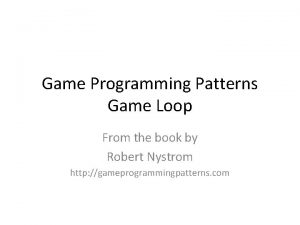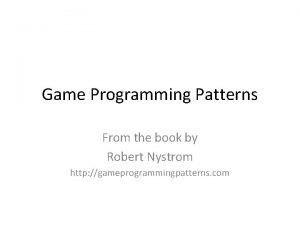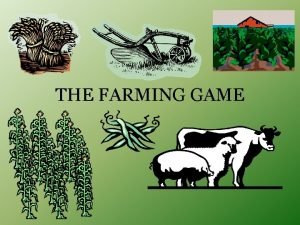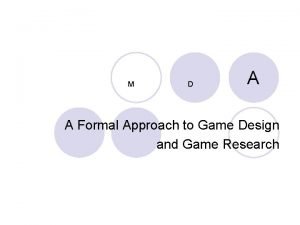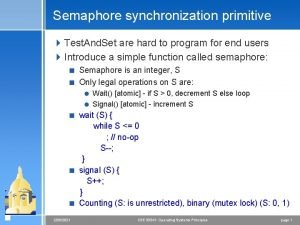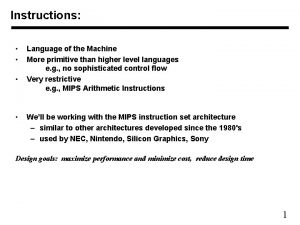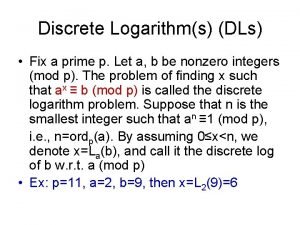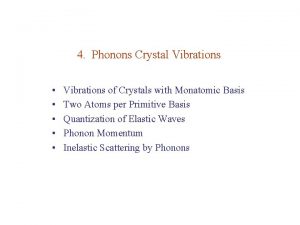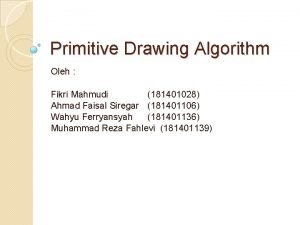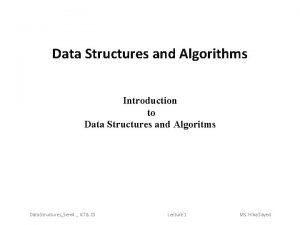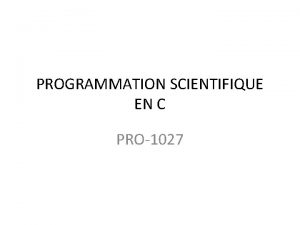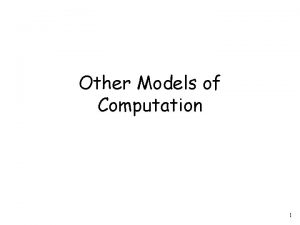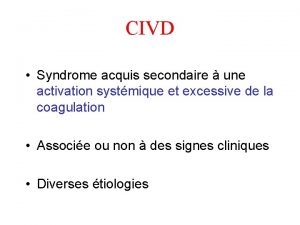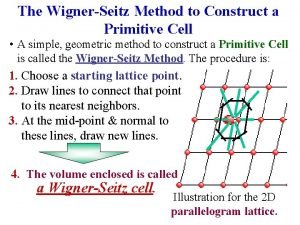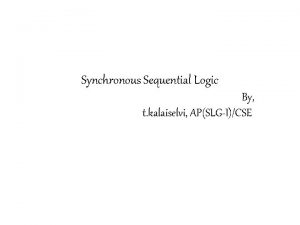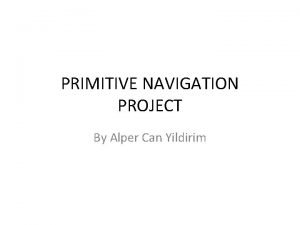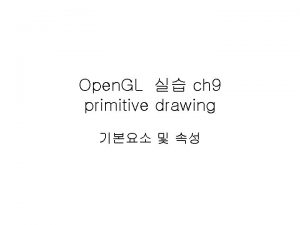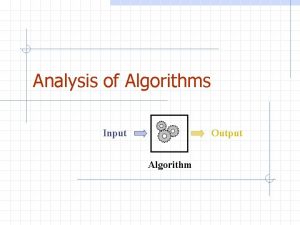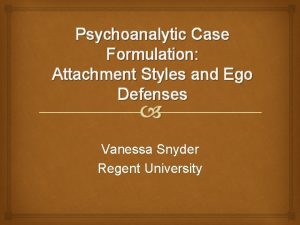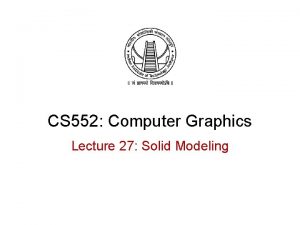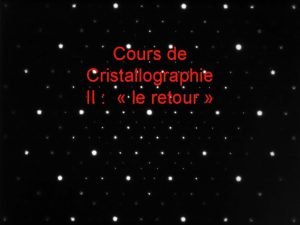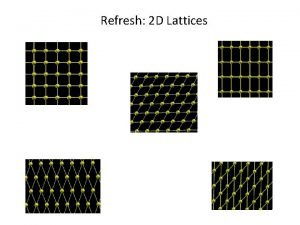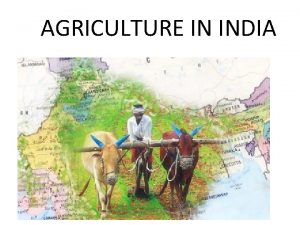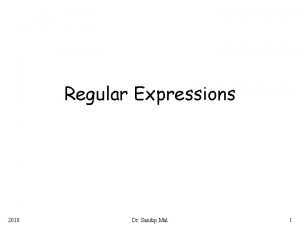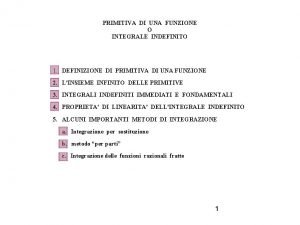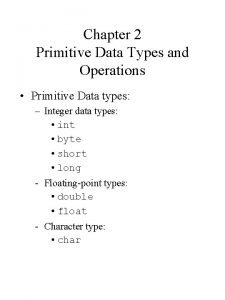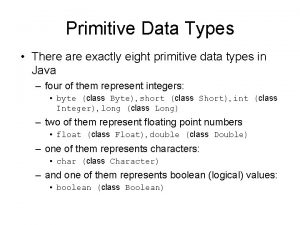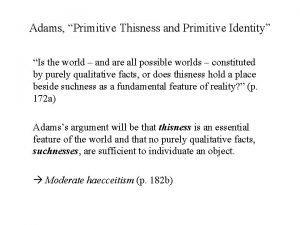3 D Game Programming 3 D Primitive MingTe






















































![Triangle float v[9][3]; gl. Begin(GL_TRANGLES); gl. Vertex 3 fv(v[0]); gl. Vertex 3 fv(v[1]); gl. Triangle float v[9][3]; gl. Begin(GL_TRANGLES); gl. Vertex 3 fv(v[0]); gl. Vertex 3 fv(v[1]); gl.](https://slidetodoc.com/presentation_image_h2/cbdb62566aa83c90d63d8fb3f243d219/image-55.jpg)







![Vertex Arrays- example const int SMALL_STAR=100; Glfloat v. Small. Stars[SMALL_STAR*2]; //(x, y) //assign position Vertex Arrays- example const int SMALL_STAR=100; Glfloat v. Small. Stars[SMALL_STAR*2]; //(x, y) //assign position](https://slidetodoc.com/presentation_image_h2/cbdb62566aa83c90d63d8fb3f243d219/image-63.jpg)





- Slides: 68

3 D Game Programming 3 D Primitive Ming-Te Chi Department of Computer Science, National Chengchi University

Wolfenstein 3 D 1992 Doom 1993 (Top) Wolfenstein 3 D (Bottom) A landmark 1993 first-person shooter (FPS)video game by id Software.

3 D Graphics – evolution

3 D Graphics – evolution

3 D Graphics

BASIC

Cartesian Plane +y (4, 3) (0, 0) (-3, -2) +z +x

Coordinate Clipping +y (150, 100) (0, 0) (-75, -50) (75, 50) +x

2 D Game world Super Mario Bros. Nintendo

3 D Game world Super Mario 3 D Land. Nintendo

Projection (camera) Getting 3 D to 2 D – Orthographic projections – Perspective projections

Viewport (camera) Mapping drawing coordinates to windows coordinates +y (0, 0) clipping space +x Window space

Representing Visuals 3 D objects – Mesh: geometry – Materials – Texture maps Lighting Shader

Start Unity in 3 D

























Pipeline Graphics State Application Vertices (3 D) Vertex Processor Rasterizer Xformed, Lit Vertices (2 D) CPU Programmable vertex processor! Fragments (pre-pixels) GPU Pixel Processor Final pixels (Color, Depth) Video Memory (Textures) Render-to-texture • Programmable pixel processor!

GPU Pipeline: Transform Vertex Processor (multiple operate in parallel) – Transform from “world space” to “image space” – Compute per-vertex lighting World space Image space

GPU Pipeline: Rasterizer – Convert geometric rep. (vertex) to image rep. (fragment) • Fragment = image fragment – Pixel + associated data: color, depth, stencil, etc. – Interpolate per-vertex quantities across pixels vertex Geometry primitive pixels

GPU Pipeline: Shade Fragment Processors (multiple in parallel) – Compute a color for each pixel – Optionally read colors from textures (images) Image from nvidia slide


Outline Open. GL Primitives – Immediate mode (4 rd Ch 3) – Vertex processing and Drawing (6 th ch 7) Fragment Processing and Buffers

PRIMITIVES

Open. GL Geometric Primitives All geometric primitives are specified by vertices GL_POINTS GL_LINE_STRIP GL_LINE_LOOP GL_POLYGON GL_TRIANGLES GL_QUADS GL_TRIANGLE_STRIP GL_TRIANGLE_FAN GL_QUAD_STRIP

Immediate mode gl. Begin(GLenum mode); … gl. Vertex 3 f(…); … … gl. End(); Open. GL 1. X, 2. X

Points gl. Begin(GL_POINTS); z = -50. 0 f; for(angle = 0. 0 f; angle <= (2. 0 f*GL_PI)*3. 0 f; angle += 0. 1 f) { x = 50. 0 f*sin(angle); y = 50. 0 f*cos(angle); // Specify the point and move the Z value up a little gl. Vertex 3 f(x, y, z); z += 0. 5 f; } gl. End(); // Done drawing points


Point. Size // Specify the point size before the primitive is specified gl. Point. Size(cur. Size); // Draw the point gl. Begin(GL_POINTS); gl. Vertex 3 f(x, y, z); gl. End();

Line gl. Begin(GL_LINES); z = 0. 0 f; for(angle = 0. 0 f; angle <= GL_PI; angle += (GL_PI / 20. 0 f)) { // Top half of the circle x = 50. 0 f*sin(angle); y = 50. 0 f*cos(angle); gl. Vertex 3 f(x, y, z); // Bottom half of the circle x = 50. 0 f*sin(angle+GL_PI); y = 50. 0 f*cos(angle+GL_PI); gl. Vertex 3 f(x, y, z); } // Done drawing points gl. End();

LINE_STRIP gl. Begin(GL_LINE_STRIP);

Line. Width gl. Line. Width(f. Curr. Size); // Draw the line gl. Begin(GL_LINES); gl. Vertex 2 f(-80. 0 f, y); gl. Vertex 2 f(80. 0 f, y); gl. End();

Line. Stipple GLushort pattern = 0 x 5555; // Stipple pattern gl. Line. Stipple(factor, pattern); // Draw the line gl. Begin(GL_LINES); gl. Vertex 2 f(-80. 0 f, y); gl. Vertex 2 f(80. 0 f, y); gl. End();
![Triangle float v93 gl BeginGLTRANGLES gl Vertex 3 fvv0 gl Vertex 3 fvv1 gl Triangle float v[9][3]; gl. Begin(GL_TRANGLES); gl. Vertex 3 fv(v[0]); gl. Vertex 3 fv(v[1]); gl.](https://slidetodoc.com/presentation_image_h2/cbdb62566aa83c90d63d8fb3f243d219/image-55.jpg)
Triangle float v[9][3]; gl. Begin(GL_TRANGLES); gl. Vertex 3 fv(v[0]); gl. Vertex 3 fv(v[1]); gl. Vertex 3 fv(v[2]); … gl. End(); 4 5 0 3 1 2 GL_TRIANGLES 1 2 3 4 0 5 GL_TRIANGLE_FAN 1 0 2 4 3 5 7 6 GL_TRIANGLE_STRIP

Winding By default, front face is defined by CCW( Counter. Clockwise Winding ) 0 1 Winding change 2 – gl. Front. Face(GL_CW); // clockwise winding

gl. Begin(GL_TRIANGLE_FAN); // Pinnacle of cone is shared vertex for fan, moved up Z axis to produce a cone instead of a circle gl. Vertex 3 f(0. 0 f, 75. 0 f); // Loop around in a circle and specify even points along the circle // as the vertices of the triangle fan for(angle = 0. 0 f; angle < (2. 0 f*GL_PI); angle += (GL_PI/8. 0 f)) { // Calculate x and y position of the next vertex x = 50. 0 f*sin(angle); y = 50. 0 f*cos(angle); // Specify the next vertex for the triangle fan gl. Vertex 2 f(x, y); } // Done drawing fan for cone gl. End();

Hidden Surface Remove Without hidden surface remove gl. Enable(GL_DEPTH_TEST);

Polygon Construction Rules All polygon must be planar. The polygon’s edge must not intersect, and the polygon must be convex. Convex polygon Non-Convex polygon

Polygon Non-Convex polygon (Concave) – Must be composited by multi-triangle

RENDER PRIMITIVE IN MODERN OPENGL Application Client side GPU Server side

Vertex Arrays void gl. Vertex. Pointer(GLint size, GLenum type, GLsizei stride, const GLvoid * pointer); – define an array of vertex data void gl. Draw. Arrays(GLenum mode, GLint first, GLsizei count); – render primitives from array data
![Vertex Arrays example const int SMALLSTAR100 Glfloat v Small StarsSMALLSTAR2 x y assign position Vertex Arrays- example const int SMALL_STAR=100; Glfloat v. Small. Stars[SMALL_STAR*2]; //(x, y) //assign position](https://slidetodoc.com/presentation_image_h2/cbdb62566aa83c90d63d8fb3f243d219/image-63.jpg)
Vertex Arrays- example const int SMALL_STAR=100; Glfloat v. Small. Stars[SMALL_STAR*2]; //(x, y) //assign position into v. Small. Stars … gl. Enable. Client. State(GL_VERTEX_ARRAY); gl. Vertex. Pointer(2, GL_FLOAT, 0, v. Small. Stars); gl. Draw. Arrays(GL_POINTS, 0, SMALL_STAR);

Vertex Array Object (VAO) Open. GL 3. 0 Web. GL Open. GL ES In modern Open. GL, VAO with VBO is the main way to render primitive. A VAO is an Open. GL Object that encapsulates all of the state needed to specify vertex data. Note that VAOs do not contain the arrays themselves; the arrays are stored in Buffer Objects

VAO – triangle example // An array of 3 vectors which represents 3 vertices static const GLfloat g_vertex_buffer_data[] = { -1. 0 f, 0. 0 f, 1. 0 f, 0. 0 f, }; Shader. Info shaders[] = { { GL_VERTEX_SHADER, "triangles. vert" }, { GL_FRAGMENT_SHADER, "triangles. frag" }, { GL_NONE, NULL } }; GLuint program = Load. Shaders(shaders); gl. Use. Program(program);

// Generate and Bind VAO GLuint Vertex. Array. ID; gl. Gen. Vertex. Arrays(1, &Vertex. Array. ID); gl. Bind. Vertex. Array(Vertex. Array. ID); Application Client side GPU Server side Glfloat [] VAO VBO // This will identify our vertex buffer GLuint vertexbuffer; // Generate 1 buffer, put the resulting identifier in vertexbuffer gl. Gen. Buffers(1, &vertexbuffer); // The following commands will talk about our 'vertexbuffer' buffer gl. Bind. Buffer(GL_ARRAY_BUFFER, vertexbuffer); // Give our vertices to Open. GL. gl. Buffer. Data(GL_ARRAY_BUFFER, sizeof(g_vertex_buffer_data), g_vertex_buffer_data, GL_STATIC_DRAW);

VAO in display() gl. Use. Program(program); GPU - Server side VAO VBO program Vertex shader 001010 … in vec 3 position // 1 st attribute buffer : vertices in vec 3 color gl. Bind. Buffer(GL_ARRAY_BUFFER, vertexbuffer); gl. Vertex. Attrib. Pointer( 0, // attribute 0. No particular reason for 0, but must match the layout in the shader. 3, // size GL_FLOAT, // type GL_FALSE, // normalized? 0, // stride (void*)0 // array buffer offset ); gl. Enable. Vertex. Attrib. Array(0); // Draw the triangle ! Starting from vertex 0; 3 vertices total -> 1 triangle gl. Draw. Arrays(GL_TRIANGLES, 0, 3); gl. Disable. Vertex. Attrib. Array(0);

Reference Open. GL Coursenote in SIGGRAPH 2013 – http: //www. cs. unm. edu/~angel/SIGGRAPH 13/An%20 Introduction%20 to%20 Open. GL %20 Programming. pptx
 Data structure definition
Data structure definition Data structures unit 1
Data structures unit 1 Integer programming vs linear programming
Integer programming vs linear programming Perbedaan linear programming dan integer programming
Perbedaan linear programming dan integer programming Programing adalah
Programing adalah Greedy vs dynamic
Greedy vs dynamic What is in system programming
What is in system programming Dot product rules
Dot product rules Texture in game programming
Texture in game programming Gameprogrammingpatterns
Gameprogrammingpatterns Game programming patterns by robert nystrom
Game programming patterns by robert nystrom Farming game rules pdf
Farming game rules pdf A formal approach to game design and game research
A formal approach to game design and game research Liar game game theory
Liar game game theory Game lab game theory
Game lab game theory Current score of pirate game
Current score of pirate game Liar game game theory
Liar game game theory Primitive testing 4
Primitive testing 4 Machine language
Machine language Primitive
Primitive Primitive gut definition
Primitive gut definition Hexagonal unit cell
Hexagonal unit cell Primitive computer science
Primitive computer science What is primitive root
What is primitive root Primitive neuroectodermal tumor
Primitive neuroectodermal tumor Difference between primary and secondary succesion
Difference between primary and secondary succesion Importance of political socialization
Importance of political socialization Vibrations of crystals with monatomic basis
Vibrations of crystals with monatomic basis Primitive drawing
Primitive drawing Non primitive data structure
Non primitive data structure Dérivée composée
Dérivée composée Exhuastively
Exhuastively Fibrinolyse primitive
Fibrinolyse primitive First organic compound which was formed in primitive ocean
First organic compound which was formed in primitive ocean Infant reflexes chart
Infant reflexes chart Wigner-seitz primitive cell
Wigner-seitz primitive cell Who's this
Who's this Physical activities of the primitive society
Physical activities of the primitive society Counting primitive operations
Counting primitive operations Primitive streak
Primitive streak Difese primitive
Difese primitive Primitive root in cryptography
Primitive root in cryptography In primitive flow table for gated latch each state has
In primitive flow table for gated latch each state has Pharyngeal arches and pouches derivatives
Pharyngeal arches and pouches derivatives Difference between primitive and classical mythology
Difference between primitive and classical mythology Primitive
Primitive Unit 1 primitive types
Unit 1 primitive types Primitive fire starting
Primitive fire starting Ankylo glossia
Ankylo glossia Fungi parts diagram
Fungi parts diagram Primitive navigation
Primitive navigation Gl_quads_strip
Gl_quads_strip How do you write an input and output algorithm?
How do you write an input and output algorithm? Primitive streak gives rise to
Primitive streak gives rise to Splitting defense mechanism example
Splitting defense mechanism example Semaphore provide a primitive yet powerful and flexible
Semaphore provide a primitive yet powerful and flexible Dore's primitive speech acts
Dore's primitive speech acts Pancrease
Pancrease Psychosexual development
Psychosexual development Solid examples
Solid examples Plan 111 cfc
Plan 111 cfc Types of unit cell
Types of unit cell Renaissance period physical education
Renaissance period physical education Primitive neuroectodermal tumor
Primitive neuroectodermal tumor Technology comes from
Technology comes from Primitive subsistence agriculture
Primitive subsistence agriculture Output primitive
Output primitive Primitive regular expressions
Primitive regular expressions Definizione primitiva
Definizione primitiva









